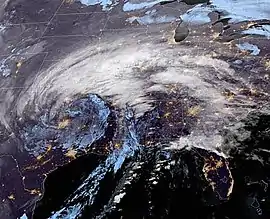2020–21 New Year's North American storm complex
The 2020–21 New Year's North American storm complex was a major storm system that brought a wide swath of snow and ice to parts of the High Plains and Central and Northeastern United States during the New Years holiday from December 30–January 2. The system began developing early on December 30 as and began spreading wintry precipitation to parts of Texas, coalescing into a low pressure system that formed near the western Gulf of Mexico. The winter storm tracked north and brought heavy snow, ice and strong winds to much of the center of the Midwest and interior parts of the Northeast and New England, causing widespread impacts and travel issues.
Category 1 "Notable" (RSI: 1.788) | |
 The storm complex impacting the Central United States early on January 1, 2021 | |
| Type | Extratropical cyclone Ice storm Winter storm |
|---|---|
| Formed | December 30, 2020 |
| Dissipated | January 3, 2021 |
| Lowest pressure | 1001 mb (29.56 inHg) |
| Tornadoes confirmed | 1 on January 1 |
| Max. rating1 | EF1 tornado |
| Maximum snowfall or ice accretion | Snowfall – 24.0 inches (61 cm) in Big Bend National Park, Texas Ice — 0.66 inches (1.7 cm) in Blue Knob Mountain, Pennsylvania |
| Damage | Unknown |
| Power outages | > 119,000 |
| Casualties | 1 fatality |
| Areas affected | High Plains, Central United States, Northeastern United States, Atlantic Canada, Nova Scotia |
Part of the 2020–21 North American winter 1Most severe tornado damage; see Fujita scale | |
Prior to the storm, Oklahoma declared a state of emergency for several dozen counties due to expected icy conditions; the ice storm came only a few months after a crippling ice storm impacted the state in late October. In other states, wintry weather caused up to 100,000 power outages. One person was killed by the storm in Missouri due to treacherous roads.
Meteorological history
On December 30, an extratropical low formed over northern Mexico, to the south of Texas. Later that day, the system low migrated into Western Texas, where snow, freezing rain and sleet began to fall, prompting winter storm warnings across the region and extending into Oklahoma.[1] During the next couple of days, the system moved northeastward, strengthening and bringing more wintry weather to the Northeast.
Preparations and impact
Ahead of and during the storm, the National Weather Service issued winter storm watches and warnings across a large swath of the Central United States, ranging from Texas to as far as Maine as the system progressed.[2] In addition, ice storm warnings were issued in parts of Illinois, particularly due to expected widespread ice accumulations of at least 0.25 inches (0.64 cm).[3]
Central United States
The unusual severity of the winter weather led to the closure of parts of Interstate 10 in Texas, which stranded dozens of travelers that had to seek shelter in two school gyms in Marfa.[4] The Big Bend National Park had to be closed due to heavy snow of up to 2 feet (24 in; 61 cm).[5]
In Oklahoma, governor Kevin Stitt declared a state of emergency for 39 counties on December 31 due to the impending hazardous winter weather.[6] The city of Oklahoma City recorded its highest daily snowfall record of about 4 inches (10 cm).[7] In addition, ice accumulations caused major problems and thousands of power outages across the state, due to freezing rain accumulating on power lines and trees and weighing them down.[8]
Kansas City in Missouri saw its greatest snowfall total in months, recording up to 3.5 inches (8.9 cm) across parts of the metro, which tied a record snowfall depth for the day of January 1, a record which was set in 1948 at the Kansas City International Airport.[9] The Missouri Department of Transportation warned travelers to stay off the roadways due to the winter weather and ice.[10] A jackknifed tractor-trailer resulted in the northbound lanes of Interstate 49 being closed early on January 1.[11] A 38-year old man was killed during the storm after being struck by another car when trying to warn residents about the icy roadways on January 1.[12]
See also
References
- "WATCH: Snow Falls in West Texas; Travel Advisory Warns of 18 Inches of Accumulation". NBC 5 Dallas-Fort Worth. Retrieved 2020-12-31.
- Sorace, Stephen (January 1, 2021). "Winter storm to bring mix of snow, freezing rain to Midwest and eastern US to kick off New Year". Fox News.
- [email protected], KEVIN BARLOW. "New year starts with Central Illinois ice storm". Herald-Review.com.
- "Hundreds Stranded When Winter Storm Shuts Down West Texas Highways | The Weather Channel - Articles from The Weather Channel | weather.com". The Weather Channel. Retrieved 2020-12-31.
- https://www.star-telegram.com/news/nation-world/national/article248203925.html
- "Gov. Stitt declares state of emergency for 39 counties ahead of winter storm". December 31, 2020.
- Staff, KOCO (January 1, 2021). "Winter storm brings freezing rain, snow, causes slick road conditions in Oklahoma". KOCO.
- Richards, Dillon (January 1, 2021). "Overnight snowstorm knocks out power for thousands in Oklahoma City". KOCO.
- https://www.kansascity.com/news/local/article248218915.html
- https://twitter.com/MoDOT_KC/status/1345003718903791616
- "Crash closes part of I-49, wrecks reported across metro during winter storm". January 1, 2021.
- https://weather.com/storms/winter/news/2020-12-30-new-years-winter-storm-plains-midwest-northeast-snow-ice